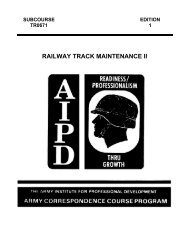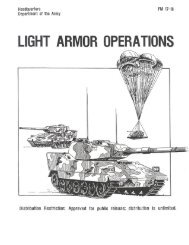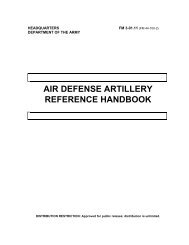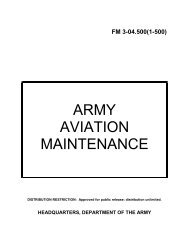fm 44-100 us army air and missile defense operations
fm 44-100 us army air and missile defense operations
fm 44-100 us army air and missile defense operations
Create successful ePaper yourself
Turn your PDF publications into a flip-book with our unique Google optimized e-Paper software.
FM <strong>44</strong>-<strong>100</strong><br />
Key Terrain<br />
A-4<br />
A-15. Key terrain is any locality or area in which the seizure, retention, or<br />
control of it will afford a marked advantage to either combatant. In the aerial<br />
dimension, these consist of terrain features that canalize or constrain <strong>air</strong><br />
threat systems, <strong>and</strong> terrain with an elevation higher than the maximum<br />
ceiling of <strong>air</strong> threat systems. Additionally, areas that can be <strong>us</strong>ed for<br />
<strong>air</strong>fields, l<strong>and</strong>ing <strong>and</strong> drop zones, or forward arming <strong>and</strong> refueling points also<br />
need to be considered as key terrain (since these areas could be <strong>us</strong>ed to<br />
support friendly or enemy <strong>air</strong> <strong>operations</strong>). Terrain can be <strong>us</strong>ed as an aid to<br />
navigation. Man-made features are also <strong>us</strong>ed as cues to navigate to targets.<br />
Air Avenues of Approach<br />
A-16. Air avenues of approach are evaluated <strong>us</strong>ing the same criteria as for<br />
ground. A good <strong>air</strong> avenue of approach will permit maneuver while providing<br />
terrain masking from surface-to-<strong>air</strong> weapon systems. Some common <strong>air</strong><br />
avenues of approach are valleys, direct lines from the threat point of origin,<br />
<strong>and</strong> riverbeds. Factors that should be <strong>us</strong>ed to determine entry <strong>and</strong> exit <strong>air</strong><br />
avenues of approach are as follows:<br />
• Type of <strong>air</strong> threat, attack profile, <strong>and</strong> ordnance.<br />
• Air threat point of origin <strong>and</strong> ground control radar positions.<br />
• Probable threat objective.<br />
• Potential to support maneuver forces.<br />
• Freedom to maneuver within the <strong>air</strong> avenue.<br />
• Protection afforded to the <strong>air</strong> system <strong>and</strong> pilot.<br />
• Air threat <strong>and</strong> pilot capabilities.<br />
A-17. Type of Air Threat. UAVs are small <strong>and</strong> el<strong>us</strong>ive. Although they<br />
<strong>us</strong>ually fly at low altitudes, their altitude can vary. Once in the target area,<br />
they may fly an orbit attempting to stay out of engagement range of ADA.<br />
Most surfaced-launched cruise <strong>missile</strong>s are terrain following <strong>and</strong> they <strong>us</strong>e<br />
terrain masking. Due to their range, they may take indirect approach routes.<br />
Ballistic <strong>missile</strong>s are not terrain dependent. They fly a straight ground track<br />
from launch point to objective. Their flight is not restricted by terrain. ASMs<br />
<strong>us</strong>ually fly direct routes from launch platform to the target. Rotary-wing<br />
<strong>air</strong>craft primarily conduct contour flights. They follow ridgelines <strong>and</strong> military<br />
crests, <strong>us</strong>ing the terrain to mask their approach to the target area. Fixedwing<br />
<strong>air</strong>craft <strong>us</strong>ually follow major terrain or man-made features. Depending<br />
on range, they may fly a straight line to the target. Ordnance or payload may<br />
affect range <strong>and</strong> altitude of the <strong>air</strong> system <strong>and</strong> th<strong>us</strong> influence the selection of<br />
avenues of approach.<br />
A-18. Point of Origin. Staff looks at the comm<strong>and</strong>er's entire area of interest<br />
when determining <strong>air</strong> avenues. Analysis begins at the enemy <strong>air</strong>field, UAV,<br />
or <strong>missile</strong> launch site <strong>and</strong> works toward the probable enemy objective. This<br />
allows a look at the big picture. The staff considers the range of the <strong>air</strong><br />
systems <strong>and</strong> location of navigation aids <strong>and</strong> ground control sites.<br />
A-19. Probable Enemy Objective. Each avenue of approach m<strong>us</strong>t end at a<br />
target, drop zone, or l<strong>and</strong>ing zone; or within reconnaissance, intelligence,











